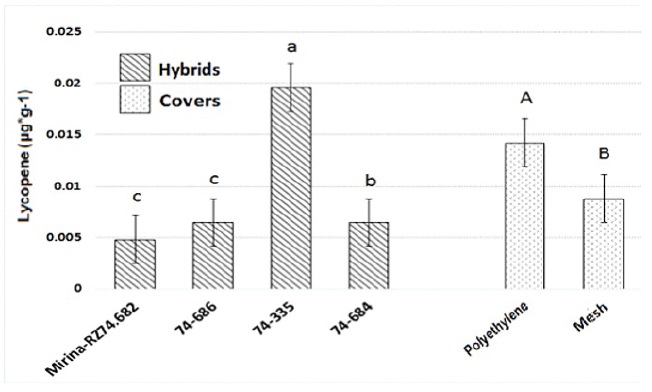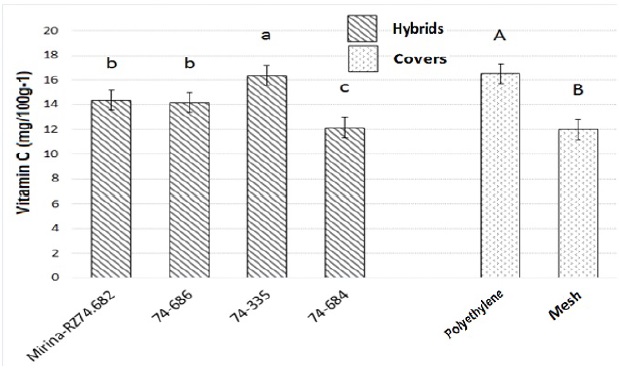INTRODUCTION
Agricultural production under protected systems favors the control of environmental factors, depending on the type of cover, structure and technical level. In this regard, tomato production in 2016 totaled 3 349 354.22 t, which were produced in 51 861.1 ha, of which 20 000 ha were grown under protected agriculture (SIAP 2016). In tomato-producing areas, the highest production occurs in greenhouse (Cih et al. 2011), due to the adequate conditions that this system offers for tomato cultivation (Max et al. 2009). However, production under greenhouse or protected systems can positively or negatively affect crop productivity and quality (Mazuelaet al. 2010). For example, if crop management is carried out properly, crop productivity and quality can be improved (Peralta et al. 2012).
Knowledge of root distribution and its relationship with water and nutrient absorption can promote plant productivity (Coelho and Or 1999). In this regard, Li et al. (2006) indicate that there is a high relationship between the number of roots and the depletion of water and nitrogen in the soil, and that the architecture, distribution and biomass of the roots differ with the soil profile. Therefore, the objective of the experiment was to determine the yield, fruit quality and root development of four tomato hybrids grafted and cultivated under anti-aphid mesh cover and greenhouse.
MATERIALS AND METHODS
Study site
The study was conducted from april to november 2014 in General Cepeda county, state of Coahuila, Mexico and in the laboratories of Universidad Autónoma Agraria Antonio Narro, located in Saltillo, Coahuila, Mexico. The coordinates of the area where the experiment was carried out are 25° 23’ 01.93" NL and 101° 27’ 10.54” WL, at 1 466 masl. The area has maximum and minimum temperatures of 27.2 and 11.9° C, respectively (SMN 2010).
Crop establishment
The crop was established in two metallic structures of 30 m long by 10 m wide, one covered with anti-aphid mesh (Environment 1) and the second one a polyethylene-covered greenhouse without climate control (Environment 2). In each structure four beds of 1.80 m wide and 28 m long were formed, where the transplanting of the tomato seedlings was carried out in April 2014. Of the grafted hybrids, four replicates of 10 plants were transplanted to the beds, of which only the five central plants of each replicate were used to take the data of the variables evaluated. All plants were kept to two stems for a density of 37 000 stems ha-1. In both environments, four plants per replicate were established in black polyethylene pots of 60 cm in length by 20 cm in diameter, which contained the same type of soil as the beds, distributed at a distance of 30 cm between each plant, to determine the distribution of the roots in the different soil profiles.
Plant material, management and evaluated variables
The plant material used was the tomato hybrids Mirina-RZ74.682, 74-686, 74-335 and 74-684 from the company Rijk Zwuan, which were grafted onto Colosus rootstock from the same company. In the beds and pots, training, pruning, fertigation and harvesting were carried out.
To estimate fruit yield and quality, only the plants grown on the beds were considered, since those established in pots were used to determine root fresh weight (RFW), dry weight (RDW) and distribution in different soil profiles. Total fruit weight per plant (TFWPP), number of clusters per plant (NCPP) and number of fruits per plant (NFPP) were determined by means of nine harvests or cuts that were made every seven days, while the polar diameter (PFD) and equatorial diameter (EFD) were determined in three fruits per cut, which were taken at random in each of the nine cuts. Vitamin C (VC) content was determined according to the methodology of the AOAC (2012) in three fruits of the sixth cut, while the lycopene content (LC) was determined in three fully-ripe fruits with the methodology proposed by Fish et al (2002). RFW and RDW were determined in three plants grown in pots of each of the treatments. In order to schematize the root distribution at different soil profiles, the extracted roots were sectioned every 15 cm from the base of the stem and with the sum of all the sections the total root weight was obtained.
Statistical analysis of data
With the RFW and RDW data, the rootstock’s root distribution in shade mesh and greenhouse was determined. The data of the variables were analyzed under an analysis of variance that included the two environments (shade mesh and greenhouse) and the four treatments, while the comparison of means was made with Tukey’s range test. All analyses were performed with SAS statistical software package 9.0.
RESULTS AND DISCUSSION
The analysis of variance detected significant differences (p ≤ 0.01) between environments (Table 1), finding the highest total fruit weight per plant under anti-aphid mesh, which was 30.1% higher than that obtained in greenhouse. On the other hand, the number of fruits per plant, number of clusters per plant, polar diameter and equatorial diameter were 15.54, 22.19, 4.04 and 5.57% higher in anti-aphid mesh than in greenhouse. Differences were detected in the content of lycopene (Figure 1) and vitamin C (Figure 2) between the growing environments, with the fruits produced under greenhouse conditions having the highest contents of both. For the source of hybrid variation no differences were found for total fruit weight per plant, while for the variables number of clusters per plant, number of fruits per plant, polar diameter and lycopene and vitamin C contents, statistical differences (p ≤ 0.01) were detected, with hybrid 74-335 having the highest values in almost all the variables evaluated. For the source of environmental variation, statistical differences (p ≤ 0.01 and p ≤ 0.05) were found in all the variables evaluated. Finally, for the environment*hybrid interaction, statistical differences (p ≤ 0.01) were only found in the variables equatorial diameter and lycopene and vitamin C contents.
Tabla 1: Yield and quality of four tomato hybrids grafted and cultivated under anti-aphid mesh and greenhouse.


Figura 1: Lycopene content of tomato hybrids grafted and cultivated under anti-aphid mesh and greenhouse. Each bar represents the average of four replicates. Different letters indicate statistical differences (Tukey, p ≤ 0.05).

Figura 2: Vitamin C content of tomato hybrids grafted and cultivated under anti-aphid mesh and greenhouse. Different letters indicate statistical differences (Tukey, p ≤ 0.05).
Yields totaling 15.668 kg m2 and 10.950 kg m2 were obtained under anti-aphid mesh and greenhouse, respectively. The lower yields obtained under greenhouse may be due to the higher temperatures in this environment. In this regard, Ortega et al. (2010) reported ungrafted tomato productivity results in greenhouse soil of 7.1.kg m2, so the higher yield obtained may be due to the effect of the rootstock, which agrees with Peil and Gálvez (2004) who found yields of 14.48.kg m2 in plants grafted and sown in hydroponic systems. This differs from the findings of Cih et al. (2011) who indicate that greenhouse tomato production is higher, which may be due to the higher temperature recorded in the greenhouse. In this regard, Páez et al. (2000) and Grijalva et al. (2011) point out that temperature plays an important role in fruit set and tomato fruit growth, which coincides with Ardila et al. (2011) who mention that under greenhouse conditions the reduction in yield is possibly due to increases in both the temperature and the rate of transpiration.
Hybrid 74-635 had the smallest average polar and equatorial fruit diameter, while hybrid 74-335 had the highest number of clusters and fruits per plant (Table 2), which coincides with Ardila et al. (2011) and Rivas et al. (2012), who indicate that when there is a high number of fruits the size of the fruit decreases, while when the number of fruits per plant is low the size of the fruit increases. Regarding the cultivation system, the greatest number of fruits and clusters, plus fruit size was under anti-aphid mesh conditions, while similar behavior was observed among hybrids, which may be due to the fact that the rootstock provided homogenous root conditions to the four hybrids (Ozlem et al. 2007, Hernández et al. 2014). The highest content of lycopene and vitamin C was in greenhouse, which may be due to the higher temperature detected in this system (Figures 1 and 2), which coincides with Brandt et al. (2006) and San Martín et al. (2012) who indicate that high temperatures inhibit lycopene production in tomatoes, while Peralta et al. (2012) indicate that the content of lycopene and vitamin C increases when the fruits have small sizes, which may be due to the effect of dilution in the fruit.
Table 2 Yield and quality of four tomato hybrids grafted and cultivated under anti-aphid mesh and greenhouse.

The environment significantly affected root development, with the plants produced under greenhouse conditions obtaining higher root fresh and dry weight. In this regard, it is known that the factors that most influence root growth are temperature, humidity and stress due to high temperatures (Meseguer and Gómez 2011), while Chassot et al. (2001) mention that root growth is related to soil characteristics and temperature (Figure 3). With regard to root distribution, Zotarelli et al. (2009) report a distribution between 51 and 78% in the first 15 cm of depth, from 15 to 28% in the depth from 15 cm to 30 cm and from 4 to 10% from 30 cm to 60 cm in depth, which coincides with the results found in the present work. Hybrids grafted and cultivated under anti-aphid mesh had higher quality than the production obtained under greenhouse. However, lycopene and vitamin C contents and accumulated root system dry matter are greater under greenhouse.











 text new page (beta)
text new page (beta)



